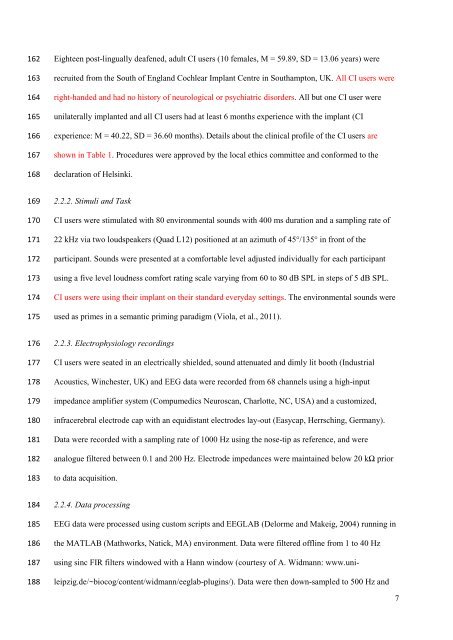Elsevier Editorial System(tm) for Hearing Research Manuscript Draft ...
Elsevier Editorial System(tm) for Hearing Research Manuscript Draft ...
Elsevier Editorial System(tm) for Hearing Research Manuscript Draft ...
You also want an ePaper? Increase the reach of your titles
YUMPU automatically turns print PDFs into web optimized ePapers that Google loves.
162<br />
163<br />
164<br />
165<br />
166<br />
167<br />
168<br />
169<br />
170<br />
171<br />
172<br />
173<br />
174<br />
175<br />
176<br />
177<br />
178<br />
179<br />
180<br />
181<br />
182<br />
183<br />
184<br />
185<br />
186<br />
187<br />
188<br />
Eighteen post-lingually deafened, adult CI users (10 females, M = 59.89, SD = 13.06 years) were<br />
recruited from the South of England Cochlear Implant Centre in Southampton, UK. All CI users were<br />
right-handed and had no history of neurological or psychiatric disorders. All but one CI user were<br />
unilaterally implanted and all CI users had at least 6 months experience with the implant (CI<br />
experience: M = 40.22, SD = 36.60 months). Details about the clinical profile of the CI users are<br />
shown in Table 1. Procedures were approved by the local ethics committee and con<strong>for</strong>med to the<br />
declaration of Helsinki.<br />
2.2.2. Stimuli and Task<br />
CI users were stimulated with 80 environmental sounds with 400 ms duration and a sampling rate of<br />
22 kHz via two loudspeakers (Quad L12) positioned at an azimuth of 45°/135° in front of the<br />
participant. Sounds were presented at a com<strong>for</strong>table level adjusted individually <strong>for</strong> each participant<br />
using a five level loudness com<strong>for</strong>t rating scale varying from 60 to 80 dB SPL in steps of 5 dB SPL.<br />
CI users were using their implant on their standard everyday settings. The environmental sounds were<br />
used as primes in a semantic priming paradigm (Viola, et al., 2011).<br />
2.2.3. Electrophysiology recordings<br />
CI users were seated in an electrically shielded, sound attenuated and dimly lit booth (Industrial<br />
Acoustics, Winchester, UK) and EEG data were recorded from 68 channels using a high-input<br />
impedance amplifier system (Compumedics Neuroscan, Charlotte, NC, USA) and a customized,<br />
infracerebral electrode cap with an equidistant electrodes lay-out (Easycap, Herrsching, Germany).<br />
Data were recorded with a sampling rate of 1000 Hz using the nose-tip as reference, and were<br />
analogue filtered between 0.1 and 200 Hz. Electrode impedances were maintained below 20 kΩ prior<br />
to data acquisition.<br />
2.2.4. Data processing<br />
EEG data were processed using custom scripts and EEGLAB (Delorme and Makeig, 2004) running in<br />
the MATLAB (Mathworks, Natick, MA) environment. Data were filtered offline from 1 to 40 Hz<br />
using sinc FIR filters windowed with a Hann window (courtesy of A. Widmann: www.uni-<br />
leipzig.de/~biocog/content/widmann/eeglab-plugins/). Data were then down-sampled to 500 Hz and<br />
7
















